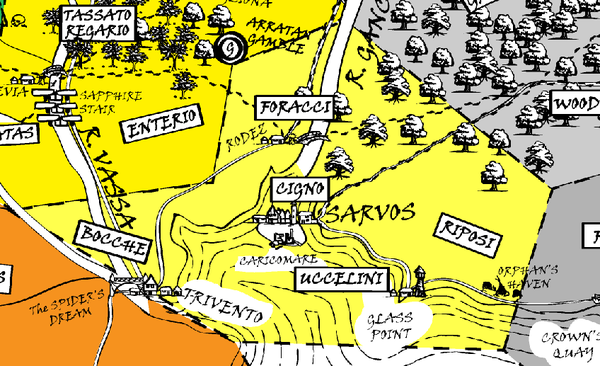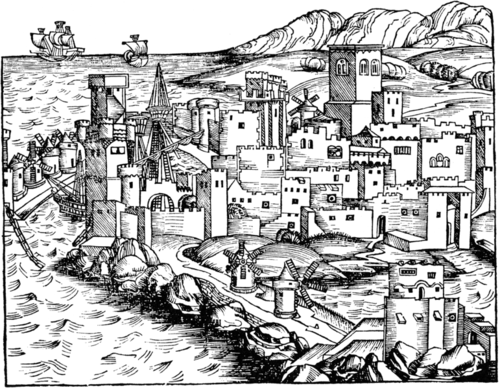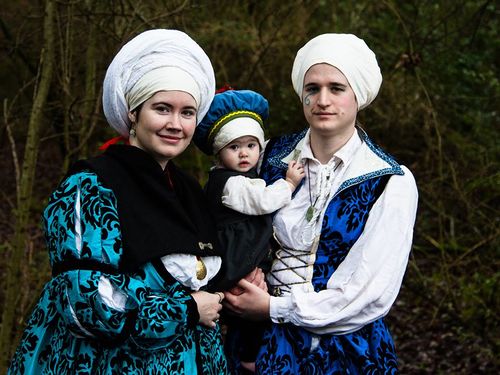Sarvos
Overview
Sarvos is constructed on an island just off the coast, like a beacon of light in the water. It bis the cultural centre of the League, and arguably the whole Empire. It takes its common epithet from the many mirrors found upon the roofs of the city, said to "sparkle like gems" during the day. Folk legend suggests that if the mirrors are shattered the city will surely fall, and for this reason some citizens carry a mirror about their person, an affectation that encourages unfair accusations of vanity.
Sarvos is as driven as any city in the League, but art is its true passion. They claim to have invented theatre, a ludicrous claim but believable in a city graced with so many theatre-houses. They are certainly the originators of the magician troupes that are now commonplace throughout the League and they are usually the centre of League performance magic. Not just theatre is popular however; there are rival opera houses whose bitter divisions are every bit as keen as those of the leading theatre troupes. Several wealthy merchant princes have endowed their collections of art on the city and there are public galleries where the most beautiful pictures and sculptures can be viewed in exchange for a ring or two.
The land around the Bay of Catazar is lush and fertile, with low flood-plains; olive farms and prime grazing lands fed by the waters of four rivers: the lazy Couros that flows along the border of Highguard and Urizen; the flighty Scorrero, whose capricious nature has drowned many an unwary river captain on its course through the Brass Coast; the broad-banked Gancio, solid and well-defended; and the furious Vassa that flows down through Tassato. The four rivers are central characters in the art and folklore of the city. All the classic literature and theatre includes them in one form or another, whether as central characters or “clowns” during the interludes. A popular game between playwrights and critics is to conceal the characters in some way and challenge the critic to locate them.
Art in all forms is held in high regard, Sarvos is famous for its architecture, but it is also a byword for excellent food, and every bar, street vendor and hostelry prides itself on providing its own speciality snack: perhaps a particular way of spicing ham, or salting and smoking beef, or an excellent dipping sauce for vegetables. It is said that an epicure can dine out every night of their life in Sarvos and never eat the same meal twice.
Cramped streets flow between soaring towers, choked with merchants, tradesmen and students. It is the site of Diora University, a prominent seat of learning that specialises in researching obscure topics for money. Here can also be found Capodomus Cathedral, one of the largest religious structures in the Empire, a towering monument encrusted with precious materials and objets d’art.
Recent History
Major Features
Asavean Embassy
Following the Spring Equinox 378YE, construction began on an official embassy to the Asavean Archipelago under the watchul eye of Miroslav, Senator for Sarvos.
Glass Point
Rodez
More of a suburb of Sarvos than a settlement in its own right. Its harbour is alive with many-oared craft of all sizes; river-boats stopping off from the north, freighters from foreign lands and pleasure-cruisers carrying the wealthy from Sarvos to their estates inland. Many visitors to Sarvos stop here to take a ferry to the island.
Trivento
Had ambitions to become a city to rival Sarvos before the Spider’s Dream was built and it lost control of the river-crossing. There’s a rumour in the bars of Sarvos that the people of Tassato aren’t entirely unhappy with the situation as it is now; better the guilds of Trivento focussed their efforts on another nation than founding a second city on the Vassa.
Caricomare
Ruined and abandoned suburb of Sarvos, destroyed by an Autumn storm during the equinox of 348 YE. The tomb of the Empress Giselle still stands in the ruins of the Alivetti guild estates here, but the ward was better known as the site of the wondrous Carciomare Quays, a great wonder unmatched elsewhere in the world. The mechanical quays were devastated by the storms that flooded this part of the city.
On the south side of Sarvos are the drowned streets of Caricomare – a shattered ruin, waist-deep in water at its highest points and submerged entirely in others. Thirty years ago, it was a prosperous suburb of Sarvos. On the night of the Autumn Equinox 348YE, however, a great storm came out of nowhere and the river burst its banks. The route of the river changed overnight and a mighty wave washed away the foundations of many buildings. In a single night, Carciomare was ruined – buildings were toppled and the streets filled with saltwater. The repairs were considered too costly and the floods created a displaced populace, compounding the overcrowding in the city. Caricomare today is an abandoned, dangerous place, a maze of flooded streets and waterlogged buildings, but it is said that riches can still be found in the depths, for those brave enough to investigate.
Orphan’s Haven
A large cave system just along the coast from Glass Point, where two shipwrecked children found a fortune in ancient pearls, stashed there by someone long-forgotten. Upon being rescued by local fishermen, they used the greater part of their wealth to finance a home for orphans in Sarvos in the name of the Little Mother. The cave itself contains carvings from lost Terunael, and some people believe it was once used as a covered port.
Regions
Bocche
Cigno
This is where the jewelled city proper is found. It spreads across the entire island, and in some places extends a short distance into the bay on sturdy quays and pontoons. On the southern side of the island are the drowned streets of Caricomare - although recent decisions of the Imperial Senate mean that these ruins might finally be about to be reclaimed for the League. Keywords: City
Foracci
Riposi
Uccelini
OOC Notes
- All the regions of Sarvos are under the control of the League (and by extension, the Empire) making Sarvos a completely Imperial territory.


